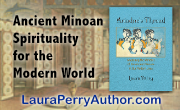Paganistan: Notes from the Secret Commonwealth
In Which One Midwest Man-in-Black Confers, Converses & Otherwise Hob-Nobs with his Fellow Hob-Men (& -Women) Concerning the Sundry Ways of the Famed but Ill-Starred Tribe of Witches.
Pagan Art Without the Pentagrams
Anyone who thinks of contemporary pagan art as the preserve of the fey, the twee, or the technically improficient needs to get his (or her) butt down to the Minneapolis Collective of Pagan Artists' Samhain 2014 exhibit, Doorways to the Underworld, stat. There she (or he) will encounter confident, conceptually mature work by artists fully in command of their respective media. All this without pentagrams. Well, there's one, but on that, more later.
Anglo-American painter Roger Williamson's A Dance for Kali is indisputably one of the stars of the show. In Williamson's previous work we frequently see figures emerging out of a dark surround: an inversion of the gold grund of Eastern Orthodox iconography, but working on the same principle. In Dance we encounter three simultaneous visual fields. In the far back—as it were, in the deep past—swirling darkness; in the middle ground, a hovering neon Kali yantra, and before it, the apex of the visual cone, the dancing Kali herself. Or is it Kali?
With her halo of flying, flaming hair and marble skin, this could be some naked Irish battle-goddess that we see in the midst of her terrible dance, a Nemain or a Morrigan. Williamson shows us here a Western Kali, an emergent visual tradition pioneered by (among others) fellow collective-member Paul B. Rucker. This mad dancer with her impossible necklace of ricocheting skulls simultaneously raises the much-vexed issue of cultural appropriation and tramples it underfoot as irrelevant. How dare we think such a Power culture-bound?
Williamson engages tradition in highly non-traditional ways. At first glance, the painting is deeply traditional: the paradigmatic yantra, the poised dance of flailing limbs, the necklace of skulls. But the yantra is seen only in part, requiring completion by the viewer's imagination. The dance pose is one most frequently associated with Shiva Nataraja, not Kali; yet here we see Kali Natarani, Kali Queen of the Dance. Gone are the multiple limbs, gone the out-thrust lolling tongue, the skirt of severed arms. This is clearly a human woman that we see, yet the pallor of her skin is vibrant with blue overtones in clear allusion to Kali's storm-colored complexion. Where does woman end and goddess begin? In Dance, Williamson raises many questions, and answers some.

There are equally strong performances by the exhibit's three guest artists. Photographer Katie Clapham's Fire Antlers dances back and forth between abstraction and representationality. What at first seems to be a helix of floating flames reveals itself to be a pair of cast antlers, each tine tipped with its own bud of flame. Even closer inspection shows the red candles and copper wires that bind them to the horns. Clapham evokes a complex array of allusions—festal bone-fires, horned gods, even the Hand of Glory—in a visual piece of stunning and elegant simplicity.

The neatly-paired juxtapositions of mixed-media artist Rmay Revard's Black Dirt White Skull—inside/outside, male/female, natural/artificial—offer a subtle, and aptly whimsical, reflection on the nature of creativity and, by extension, the very nature of the new paganisms themselves. Looking like a Halloween costume hung up and ready to be worn, a deer skull antlered with branches “wears” a black dress hung with pendant jet stalactites. The formerly living—animal, vegetal—pairs with the mineral and, daringly, with the man-made as well. We see here the inner, the skeleton, along with the outer, the clothing. Missing is the living flesh which alone can unite the two and step out to dance; and this, Revard implies, must inevitably come from the viewer herself.

I will admit to a passion for ceramics (indeed, my home is filled with them), and ceramicist Ellie Bryan does not disappoint with her varied offering of sculpture, and figured dishes and jars. Particularly stand-out, at least for this confirmed aigophile (some might say, aigolator), are Spirit Vase I (above) and Spirit Vase 2 (not shown), which respectively show the Goat in his Day-side—with blue sky, owls, and flowers—and Night-side, with darkness, ravens and skulls. Bryan's slightly florid handling of the sgrafitto (engraving) technique and composition, with its strikingly balanced presentation of static and dynamic, recti- and curvilinearity, horizontality and verticality, pair well with the restrained elegance of the vases themselves. It is on the breast of the Dark Goat that we find, fittingly, the exhibit's lone pentagram, but here the pentagram serves the artist's overall intent, instead of merely shouting “Pagan!” These artists have moved far beyond the need to brand their work.
In keeping with the season, the gallery is haunted by its own resident ghost. Having viewed Anne Marie Forrester's striking Bear Priestess, turn your back on the painting—difficult as it may be—and look to the opposite wall of the gallery. There you will see the reflection of Ali Beyer's Sparky: His Song Will be Remembered gazing back, as it were, from the outside of the (second-floor) window. It is one final arresting moment in an exhibit with many such experiences to offer.
Sensitively displayed, lit, and curated by Ali Beyer, professor of Contemporary Media at Chicago's Columbia College, Doorways to the Underworld continues at the Stevens Square Center for the Arts, 1905 Third Avenue South, in Minneapolis ( stevensarts.org ) for two more weeks, through November 15th, with viewing Saturdays and Sundays 1 to 5 pm. The closing reception Saturday, November 15, 7:30-11:00 pm, will feature live music by Crow Call.
Comments
-
Please login first in order for you to submit comments






















